Risk-Based Monitoring Software Market Size
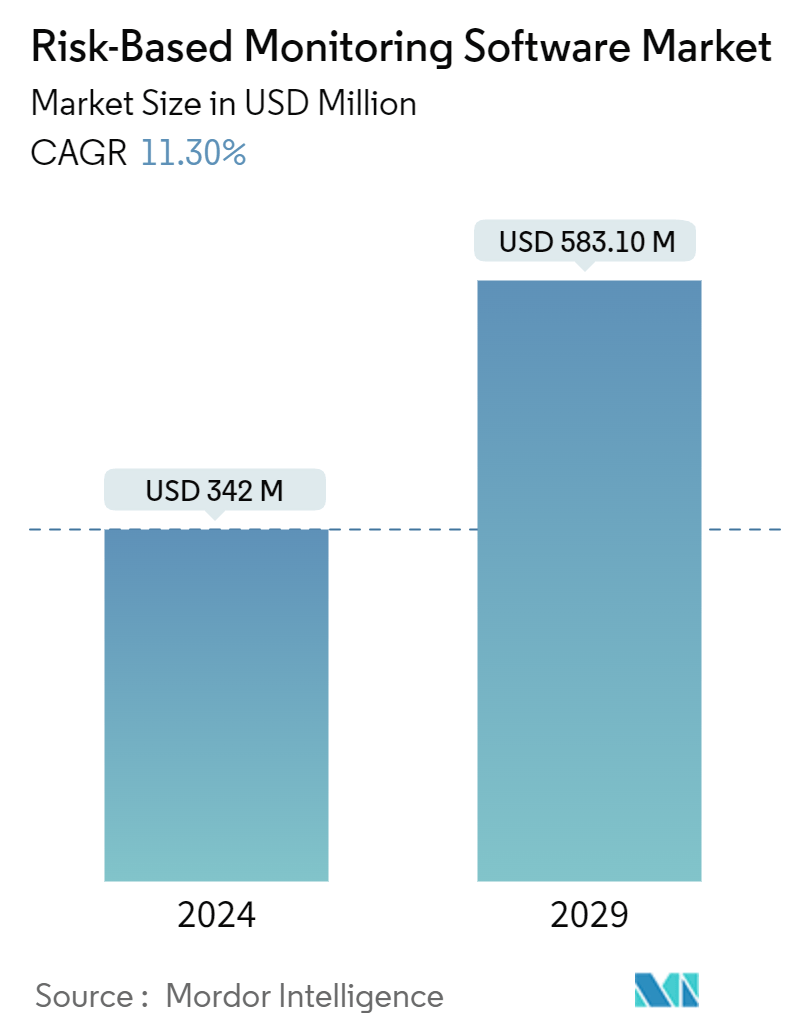
| Study Period | 2019 - 2029 |
| Market Size (2024) | USD 342 Million |
| Market Size (2029) | USD 583.10 Million |
| CAGR (2024 - 2029) | 11.30 % |
| Fastest Growing Market | Asia Pacific |
| Largest Market | North America |
| Market Concentration | Medium |
Major Players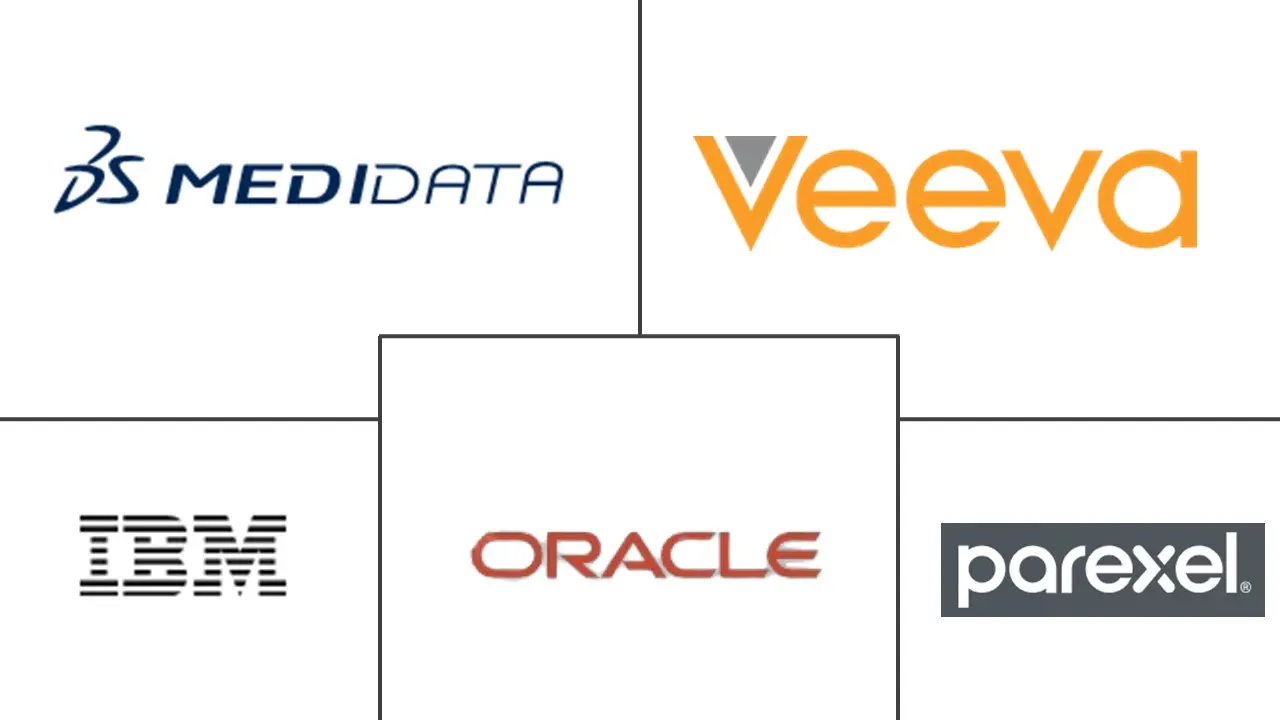
*Disclaimer: Major Players sorted in no particular order |
Risk-Based Monitoring Software Market Analysis
The Risk-Based Monitoring Software Market size is estimated at USD 342 million in 2024, and is expected to reach USD 583.10 million by 2029, growing at a CAGR of 11.30% during the forecast period (2024-2029).
Increasing demand for high-efficiency, risk-based monitoring software, coupled with growing government funding and support for clinical trials and technological advancements, is expected to expand the market.
As regulatory bodies promote risk-based monitoring approaches, there is a growing demand for RBM software that can streamline data collection, analysis, and risk assessment processes. These software solutions leverage technologies like AI and machine learning to identify and prioritize high-risk areas, thereby optimizing monitoring efforts and enhancing overall trial efficiency. For example, in April 2023, the United States Food and Drug Administration (FDA) issued guidance on using risk-based approaches to monitor the progress of clinical research involving human drug and biological products, medical devices, and combination products. Clinical investigation monitoring is an important quality control tool for ensuring that research activities are carried out as intended. This guidance provides recommendations on how to plan a monitoring approach, develop the content of a monitoring plan, and address and communicate monitoring results. Hence, the surge in demand for advanced risk-based monitoring (RBM) software aligns with regulatory guidance emphasizing risk-based approaches. This, strengthened by increased government funding and the growing adoption of efficient clinical trial management practices, will drive market expansion growth during the forecast period.
Also, the demand for clinical trials is steadily increasing worldwide, driven by advancements in medical research and the rise of personalized medicine. Technological advancements, innovative data analysis methods, and the increasing adoption of decentralized clinical trials (DCTs) are transforming the field of clinical trials.
Moreover, as clinical trials expand in complexity, the demand for efficient monitoring solutions grows significantly. These solutions are crucial for maintaining data integrity, ensuring patient safety, and meeting rigorous regulatory standards. For instance, according to the article published by Springer in March 2022, risk-based monitoring (RBM) aims to identify events or trends that influence the quality of trials, particularly in terms of participant safety and data integrity. The adoption of RBM approaches is increasing due to their efficiency, regulatory support, and enhancement of trial quality. Thus, by enhancing data quality, streamlining monitoring processes, and optimizing resource utilization the growing demand for clinical trials drives the adoption of the market.
Additionally, the demand for web-based delivery modes is primarily driven by the rising adoption of web-based risk monitoring solutions. For instance, as per the article published by the Sustainability Journal in May 2023, the risk-based monitoring software approach is a fundamental method employed in implementing management systems, utilizing requirements from management standards and effective use in improved scalability. These solutions streamline trial management processes and facilitate real-time data access by eliminating the need for local installations and enabling access through web browsers. Thus, this proactive approach reduces costs, improves trial integrity, and meets management standards, driving growth in the risk-based monitoring software market by meeting industry demands for efficiency and regulatory compliance.
Thus, the market is expected to continue to grow in the coming years due to the aforementioned factors, such as the increasing adoption of web-based risk monitoring solutions and the rising demand for clinical trials for technological advancements. However, the high cost of implementation and data privacy and security concerns create a significant obstacle to adopting artificial intelligence during the forecast period.
Risk-Based Monitoring Software Market Trends
The Service Segment is Expected to Hold a Significant Share in the Market During the Forecast Period
Risk-based monitoring (RBM) represents a shift from traditional, resource-intensive on-site monitoring towards a more targeted and data-driven approach in clinical trial management. Service providers offer expertise in implementing RBM strategies, conducting risk assessments, designing monitoring plans, and managing trial operations.
Service providers offer ongoing support in data analytics, performance monitoring, and risk mitigation strategies throughout the clinical trial. For instance, in an article published by Therapeutic Innovation & Regulatory Science in February 2024, risk-based monitoring (RBM) provides a formal approach to enhancing efficiency, speed, and quality in clinical trials. This is accomplished by prioritizing and mitigating essential safety and efficacy data risks. Hence, as clinical trials increasingly adopt RBM strategies to enhance efficiency, speed, and quality, the demand for specialized services to implement these methodologies is driving growth in the service segment of the risk-based monitoring software market during the forecast period.
Additionally, providers specializing in RBM services offer expertise in risk management, data analytics, and regulatory compliance. RBM services ensure clinical trials' highest quality, accuracy, and validity. For instance, Wemedoo AG's 2024 update stated that the service involves remotely overseeing and analyzing trial data and study activities. Hence, the company's RBM services are crucial in driving growth in the service segment of the risk-based monitoring software market. They provide specialized expertise, ensure data integrity, aid regulatory compliance, enhance operational efficiency, and foster client confidence through a focus on quality and reliability in clinical trial management, which is expected to contribute to the market segment's growth during the forecast period.
Hence, the growing adoption of service providers offering ongoing support in data analytics with the help of RBM and companies focusing on new services for clinical trials is expected to continue in the coming years.
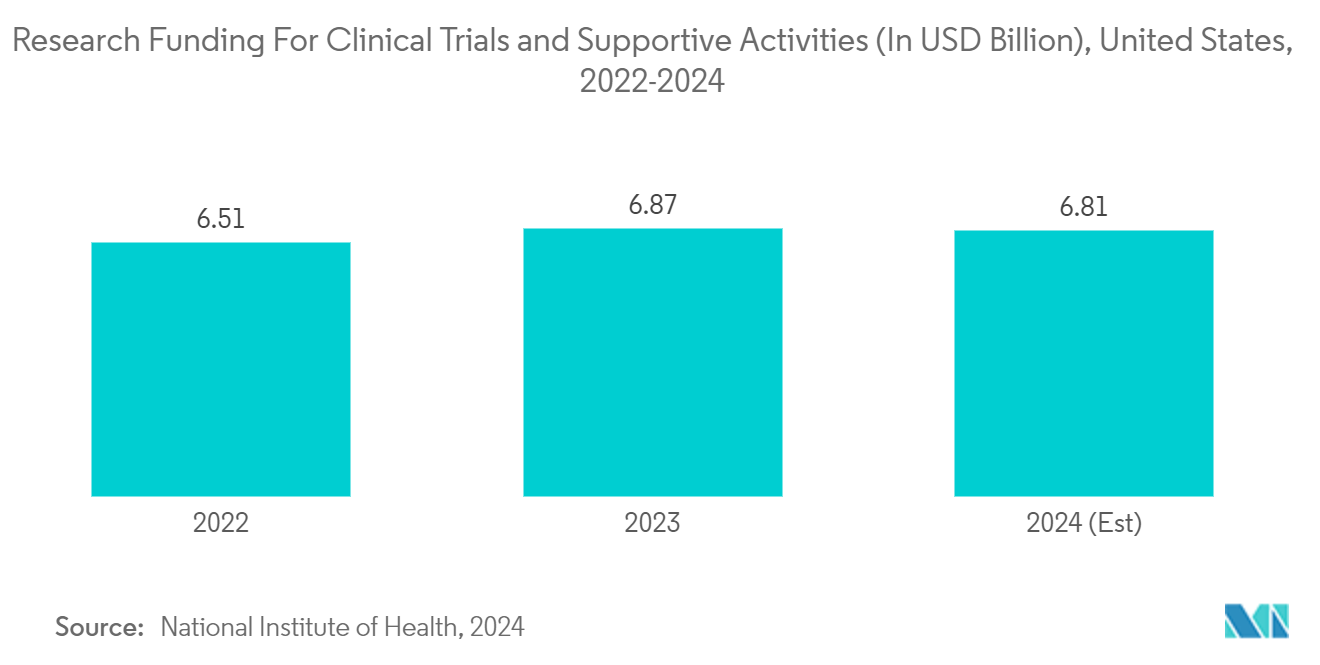
North America is Expected to Hold a Significant Market Share During the Forecast Period
The market's growth in the region is vastly attributed to the rising government investment in clinical trial activity, the presence of major key players, and acquisition by manufacturers in the region.
Government investments in clinical trials surge demand for efficient trial management solutions. RBM Software offers advanced analytics and risk-based methodologies that streamline monitoring efforts, enhance data quality, and ensure compliance with regulatory standards. For instance, according to the National Institute of Health, in March 2024, the United States government invested USD 6,878 million in clinical trials and supportive activities in 2023. Thus, government investments in clinical trials promote the adoption of RBM Software and highlight the necessity for robust data management, patient safety, and regulatory compliance, which will further increase the market expansion during the forecast period.
Additionally, strategic partnerships play a crucial role in advancing innovation and efficiency in the evolving landscape of clinical research and pharmaceutical development. For instance, in February 2024, Medidata signed a partnership with pharmaceutical product development (PPD), a clinical research business of Thermo Fisher Scientific Inc. The renewed agreement highlights utilizing the Medidata platform alongside Medidata adjudicate and other rave products. These tools are essential in supporting PPD's efforts to advance drug development programs for its clients. Thus, the partnership between Medidata and PPD strengthens capabilities in clinical trial management and RBM, fostering innovation and efficiency in drug development processes across North America.
Therefore, owing to the aforementioned factors, like government investment in clinical trial activity and manufacturer partnerships, the market is expected to witness significant growth in the region.
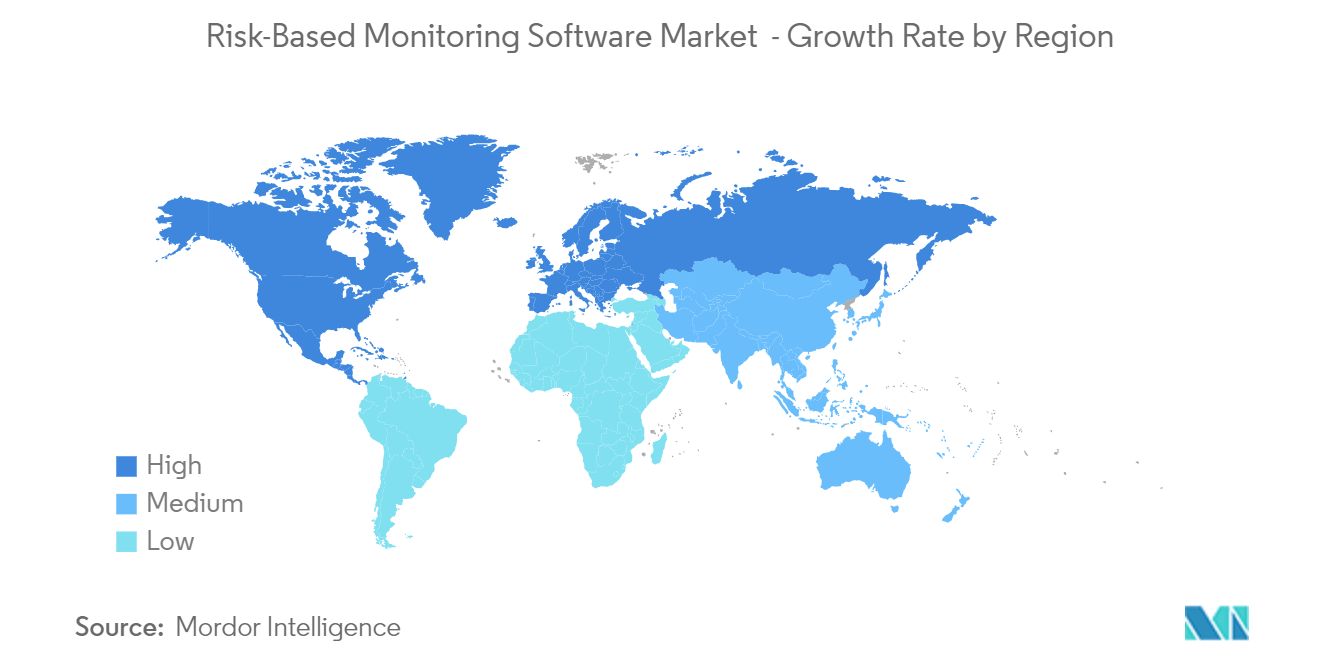
Risk-Based Monitoring Software Industry Overview
The risk-based monitoring software market is moderately consolidated due to the presence of several companies operating globally and regionally. Major players in the market focus on regulatory approval in particular countries and product launches to expand their presence in the global market. The competitive landscape includes analyzing a few international and local companies that hold market shares and are well known, including Medidata Solutions Inc., Parexel International Corporation, IBM Corporation, Veeva Systems, and DSG Inc.
Risk-Based Monitoring Software Market Leaders
-
Medidata Solutions
-
Parexel International
-
IBM Corporation
-
Oracle
-
Veeva Systems
*Disclaimer: Major Players sorted in no particular order
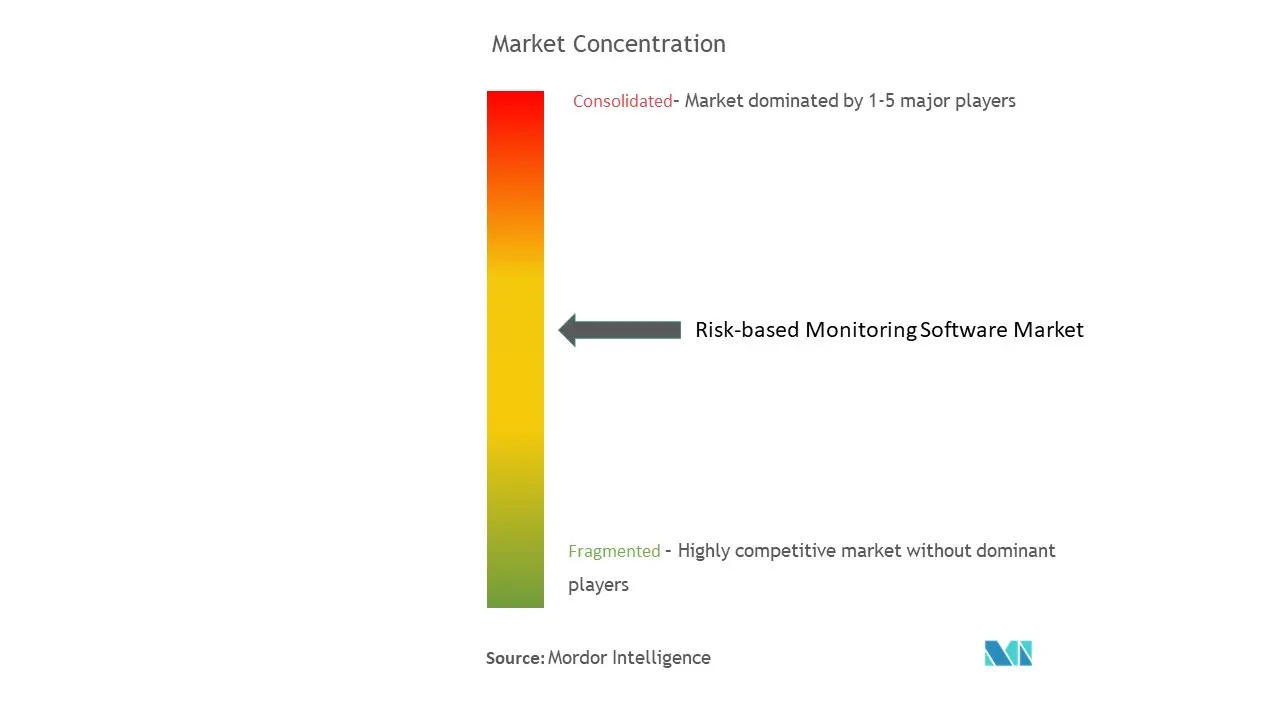
Risk-Based Monitoring Software Market News
- June 2024: Medidata unveiled its offering, the Medidata Clinical Data Studio. This innovative platform is designed to empower stakeholders, granting them enhanced control over data quality and, in turn, expediting the delivery of safer trials to patients. This Medidata Clinical Data Studio supports the principles of risk-based monitoring (RBM) by enhancing data quality control and accelerating trial timelines.
- April 2024: Parexel and Palantir Technologies Inc. unveiled a multi-year strategic alliance. The collaboration aims to harness artificial intelligence (AI) to expedite and improve the safety of clinical trials, catering specifically to the global biopharmaceutical clientele. This collaboration highlights Parexel's dedication to improving the efficiency of clinical trials while upholding strict safety and regulatory standards. Further, this strategic partnership supports the advancement of AI-driven efficiencies in clinical trials, aligning with the objectives of the RBM Software to improve trial outcomes and operational effectiveness.
Risk-Based Monitoring Software Market Report - Table of Contents
1. INTRODUCTION
1.1 Study Assumptions and Market Definition
1.2 Scope of the Study
2. RESEARCH METHODOLOGY
3. EXECUTIVE SUMMARY
4. MARKET DYNAMICS
4.1 Market Overview
4.2 Market Drivers
4.2.1 High Efficiency of Risk-Based Monitoring Software Coupled with Growing Government Funding and Support for Clinical Trials
4.2.2 Advancements in Technology
4.3 Market Restraints
4.3.1 High Cost of Implementation
4.3.2 Data Privacy and Security Concerns
4.4 Porter's Five Force Analysis
4.4.1 Threat of New Entrants
4.4.2 Bargaining Power of Buyers/Consumers
4.4.3 Bargaining Power of Suppliers
4.4.4 Threat of Substitute Products
4.4.5 Intensity of Competitive Rivalry
5. MARKET SEGMENTATION (Market Size by Value - USD)
5.1 By Component
5.1.1 Software
5.1.2 Services
5.2 By Delivery Mode
5.2.1 Web Based
5.2.2 On-premise
5.2.3 Cloud-based
5.3 By End User
5.3.1 Pharma and Biopharmaceutical Companies
5.3.2 Medical Device Companies
5.3.3 Contract Research Organizations (CRO)
5.3.4 Other End Users
5.4 Geography
5.4.1 North America
5.4.1.1 United States
5.4.1.2 Canada
5.4.1.3 Mexico
5.4.2 Europe
5.4.2.1 Germany
5.4.2.2 United Kingdom
5.4.2.3 France
5.4.2.4 Italy
5.4.2.5 Spain
5.4.2.6 Rest of Europe
5.4.3 Asia-Pacific
5.4.3.1 China
5.4.3.2 Japan
5.4.3.3 India
5.4.3.4 Australia
5.4.3.5 South Korea
5.4.3.6 Rest of Asia-Pacific
5.4.4 Rest of the World
6. COMPETITIVE LANDSCAPE
6.1 Company Profiles
6.1.1 Medidata Solutions Inc.
6.1.2 Parexel International Corporation
6.1.3 IBM Corporation
6.1.4 Veeva Systems
6.1.5 DSG Inc.
6.1.6 MedNet Solutions Inc.
6.1.7 Signant Health
6.1.8 OpenClinica LLC
6.1.9 Oracle
6.1.10 Anju Software
- *List Not Exhaustive
7. MARKET OPPORTUNITIES AND FUTURE TRENDS
Risk-Based Monitoring Software Industry Segmentation
As per the scope of the report, the risk-based monitoring (RBM) software market centers on software solutions tailored to streamline clinical trial monitoring. These solutions prioritize resources based on identified risks, boost efficiency, and ensure regulatory compliance. They leverage advanced analytics and real-time data monitoring to enhance trial outcomes, reduce costs, and ease resource burdens. The risk-based monitoring software market is segmented by component, delivery mode, end-user, and geography. By component, the market is segmented into software and services. The market is segmented by delivery mode into web-based (on-demand), on-premise, and cloud-based (SAAS). The market is segmented by end users into pharma and biopharmaceutical companies, medical device companies, contract research organizations (CROs), and other end users. By geography, the market is segmented into North America, Europe, Asia-Pacific, and Rest of the World. For each segment, the market sizing and forecasts are done based on value (in USD).
| By Component | |
| Software | |
| Services |
| By Delivery Mode | |
| Web Based | |
| On-premise | |
| Cloud-based |
| By End User | |
| Pharma and Biopharmaceutical Companies | |
| Medical Device Companies | |
| Contract Research Organizations (CRO) | |
| Other End Users |
| Geography | ||||||||
| ||||||||
| ||||||||
| ||||||||
| Rest of the World |
Risk-Based Monitoring Software Market Research FAQs
How big is the Risk-Based Monitoring Software Market?
The Risk-Based Monitoring Software Market size is expected to reach USD 342 million in 2024 and grow at a CAGR of 11.30% to reach USD 583.10 million by 2029.
What is the current Risk-Based Monitoring Software Market size?
In 2024, the Risk-Based Monitoring Software Market size is expected to reach USD 342 million.
Who are the key players in Risk-Based Monitoring Software Market?
Medidata Solutions, Parexel International, IBM Corporation, Oracle and Veeva Systems are the major companies operating in the Risk-Based Monitoring Software Market.
Which is the fastest growing region in Risk-Based Monitoring Software Market?
Asia Pacific is estimated to grow at the highest CAGR over the forecast period (2024-2029).
Which region has the biggest share in Risk-Based Monitoring Software Market?
In 2024, the North America accounts for the largest market share in Risk-Based Monitoring Software Market.
What years does this Risk-Based Monitoring Software Market cover, and what was the market size in 2023?
In 2023, the Risk-Based Monitoring Software Market size was estimated at USD 303.35 million. The report covers the Risk-Based Monitoring Software Market historical market size for years: 2019, 2020, 2021, 2022 and 2023. The report also forecasts the Risk-Based Monitoring Software Market size for years: 2024, 2025, 2026, 2027, 2028 and 2029.
Risk-Based Monitoring Software Industry Report
Statistics for the 2024 Risk-Based Monitoring Software market share, size and revenue growth rate, created by Mordor Intelligence™ Industry Reports. Risk-Based Monitoring Software analysis includes a market forecast outlook for 2024 to 2029 and historical overview. Get a sample of this industry analysis as a free report PDF download.



